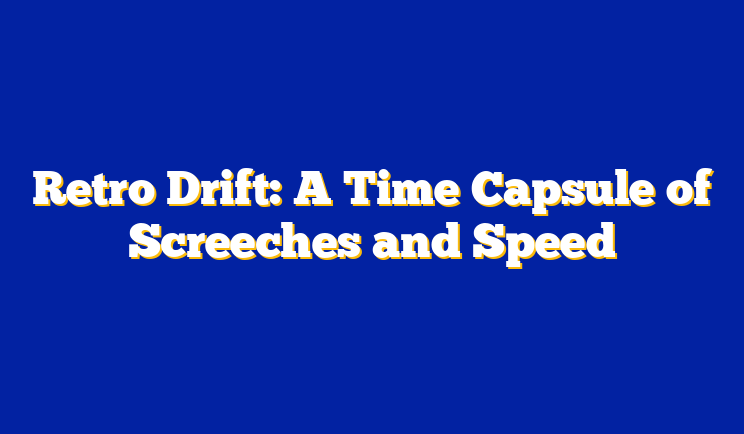The year is 1992. You walk into the arcade, greeted by the cacophony of beeps, buzzes, and pixelated glory. Your eyes scan the cabinets, finally landing on a vibrant title with blocky cars tearing down neon-lit tracks. This is your introduction to the world of retro drift, a genre that would leave an indelible mark on your gaming memories.
Fast forward to 2024. The arcades might be fading, but the spirit of retro drift burns bright. It’s more than just a gaming relic; it’s a portal to a simpler time, where gameplay reigned supreme and every pixel held immense value. Let’s delve deeper into this captivating world, exploring its nostalgic charm, the mastery of the slide, and the vibrant community that keeps it alive.
Download Geometry Dash APK from here.
A Love Letter to Low-Res Perfection
Unlike their modern counterparts boasting hyper-realistic textures and physics simulations, retro drift games embrace minimalism. Think chunky cars reminiscent of Legos, vibrant tracks composed of colorful squares, and backgrounds that wouldn’t look out of place in a classic arcade cabinet. But don’t mistake this simplicity for a lack of depth. This deliberate design choice fosters a laser-sharp focus on core mechanics – every pixel counts, every turn demands precision. It’s like a skilled painter working with a limited palette, creating masterpieces with bold strokes and vibrant colors.
Mastering the Art of the Sideways Dance
Forget complex physics simulations and tire wear calculations. Retro drift games prioritize control and responsiveness, making them instantly accessible yet surprisingly challenging. Mastering the art of the drift boils down to a few key principles: timing, momentum, and angle. It’s not about brute force; it’s about a delicate dance between speed and control. A well-timed tap of the drift button, combined with the slightest twitch of the joystick, sends your pixelated chariot into a satisfying sideways slide. You hug the corners like a dancer pirouetting on pointe, pixels blurring as you chase that perfect line.
The beauty lies in the simplicity of this mechanic. Yet, beneath this seemingly straightforward concept lies a surprising depth of challenge. Each track presents its own unique set of obstacles, demanding different approaches and precise maneuvers. Mastering the intricacies of each corner, learning to balance drift angles with speed, and pushing your reaction times to the limit – that’s where true mastery lies. It’s not about just completing the track; it’s about carving your name into the leaderboard with the most stylish and efficient run.
A Symphony of Pixels and Passion
One of the most alluring aspects of retro drift is its accessibility. The barrier to entry is low, making it easy for newcomers to pick up and start drifting their way to glory. The controls are intuitive, the tracks are visually stimulating, and the basic mechanics are quickly grasped. However, beneath this welcoming facade lies a surprisingly deep well of challenge. Mastering the nuances of each track, refining your drifting skills, and pushing your limits – that’s where the true addiction lies.
But retro drift isn’t just about individual journeys. It’s a genre fueled by a passionate community that transcends individual titles. Online leaderboards become battlegrounds where pixelated titans clash for bragging rights. Forums buzz with discussions, tips, and strategies, fostering a sense of camaraderie that keeps the genre alive. Developers, both veterans and newcomers, continue to breathe life into the scene with new games, mods, and challenges, each adding their unique pixelated brushstrokes to the canvas.
Beyond the Screen: A Real-World Legacy
The influence of retro drift extends beyond the digital realm. It has inspired real-world events and competitions where skilled drifters take to the streets in classic cars, channeling the spirit of their pixelated counterparts. The screech of tires, the plume of smoke, and the precise maneuvers – it’s like stepping straight out of a retro game and into a live-action spectacle. Additionally, the minimalist design principles of retro drift games have found their way into modern titles. Developers are increasingly recognizing the power of simplicity, focusing on core mechanics and intuitive controls rather than overwhelming complexity.
A Nostalgic Journey Through Time
Playing a retro drift game is more than just a trip down memory lane. It’s a reminder of the joy found in simple mechanics, the thrill of mastering a challenge, and the power of a passionate community. It’s a testament to the enduring power of nostalgia, reminding us that sometimes, the greatest journeys are best experienced in low resolution. It’s a celebration of creativity, where limitations become fuel for innovation, and pixels dance to the rhythm of speed and skill.
Retro Drift: Frequently Asked Questions
What exactly is retro drift?
Retro drift refers to a genre of video games, typically from the 8-bit and 16-bit eras, focused on drifting mechanics with simplified graphics and gameplay. Imagine pixelated cars tearing around neon-lit tracks, mastering the art of sideways slides with intuitive controls.
Why is it so popular?
It’s a combination of factors! Nostalgia plays a big role, reminding players of simpler times in gaming. Additionally, the accessible controls and focus on core mechanics make it easy to pick up and endlessly challenging to master. The vibrant community, online leaderboards, and constant stream of new titles and mods also keep the scene alive and thriving.
Do I need any special skills to play retro drift games?
No, the beauty lies in their accessibility! They’re perfect for newcomers who simply want to experience the joy of drifting. However, mastering the intricate tracks, perfecting drift angles, and pushing your reaction times require dedication and practice, offering depth for skilled players too.

